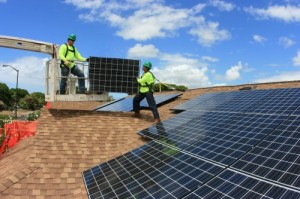The U.S. Solar Industry: A Real And Growing Job Creator
 After being bombarded with political ads for the past few months, most of us are relieved we no longer encounter them everywhere we turn. But imagine if you heard one like this:
After being bombarded with political ads for the past few months, most of us are relieved we no longer encounter them everywhere we turn. But imagine if you heard one like this: I’m the candidate who can take credit for adding nearly 14,000 American workers in the past year and supporting an industry that has experienced an astounding 27 percent job growth since 2010. I’m creating highly skilled, domestic jobs that pay well. I’m the U.S. solar industry and I approve this message.
After a grueling and largely negative campaign season, this is the kind of positive message Americans want to hear. And it is backed by fact, not spin.
Today, my organization, The Solar Foundation, released its third annual National Solar Jobs Census, which found that the U.S. solar industry now employs 119,016 Americans. That’s an increase of 13,872 workers and a 13.2 percent employment growth rate over the previous year’s total. That’s a job creation record any candidate would love to run on.
Looking at these results more closely, Census 2012 found that installers led the way in job growth, employing 57,177 Americans as of September 2012 (a 17.5 percent increase over the revised 2011 figure). The installation subsector remains the largest employer in the U.S. solar industry, and continues to provide highly skilled jobs that, by their very nature, cannot be outsourced. The Census also found that much of the installer growth occurred at larger firms. This suggests that the U.S. solar industry is moving into period of consolidation and maturation that will ultimately make the industry more robust and stable.
Additionally, the Census found that the sales and distribution subsector experienced a 23.1 percent increase, now employing 16,005 Americans. Employment in “other” solar jobs, primarily in research & development and finance, experienced the largest growth rate – 46.1 percent – bringing the total for this composite category to 8,105 U.S. solar workers.
Unfortunately (though not surprisingly), not all of the findings in Census 2012 tell a happy tale. As suggested by the failure of a handful of module manufacturers and the high-profile media coverage these closures received, the manufacturing subsector had the weakest showing in Census 2012 – shedding nearly 8,200 jobs over the period we studied. At 29,742 solar workers, manufacturing still accounts for nearly one-quarter of solar jobs in the U.S., but many of the surviving firms are forced to subsist on razor-thin margins. The difficulties facing this subsector stem from increased global competition in module manufacturing, leading to a decline in component prices. This trend, however, has had a dual effect: putting a damper on job creation upstream, but feeding a boom in installation – and therefore jobs – downstream. In fact, employment gains in the installation sector were enough to single-handedly offset the job losses in manufacturing.
Equally notable is that nearly 50 percent of the more than 1,000 companies surveyed for the Census expressed great optimism for future solar employment growth. Overall, respondents reported that they anticipate 17.2 percent employment growth over the next 12 months, representing an addition of 20,000 new solar workers. If the past is any indication, these growth numbers may be overestimates. However, they are a good predictor that the solar industry will remain on its upward growth trajectory.
A campaign is not a campaign without an opponent and some negative ads. Opponents of clean, renewable energy – chiefly those seeking to protect their market share – would likely try to claim that green jobs are a myth. Unfortunately for them, the facts support solar.
The National Solar Jobs Census 2012 measured employment growth in the solar industry between August 2011 and September 2012. While solar jobs grew by 13.2 percent during this period, employment in the overall economy grew at a rate of only 2.3 percent (BLS) and the fossil fuel electric generation industry actually lost jobs – shedding 3,857 workers, or 3.77 percent, of its workforce (EMSI).
This impressive job growth, combined with a 92 percent voter approval rating, make solar the kind of candidate we can all support. This includes the President as he begins his second term, and the new Congress as it members take office.
You can return to the main Market News page, or press the Back button on your browser.

